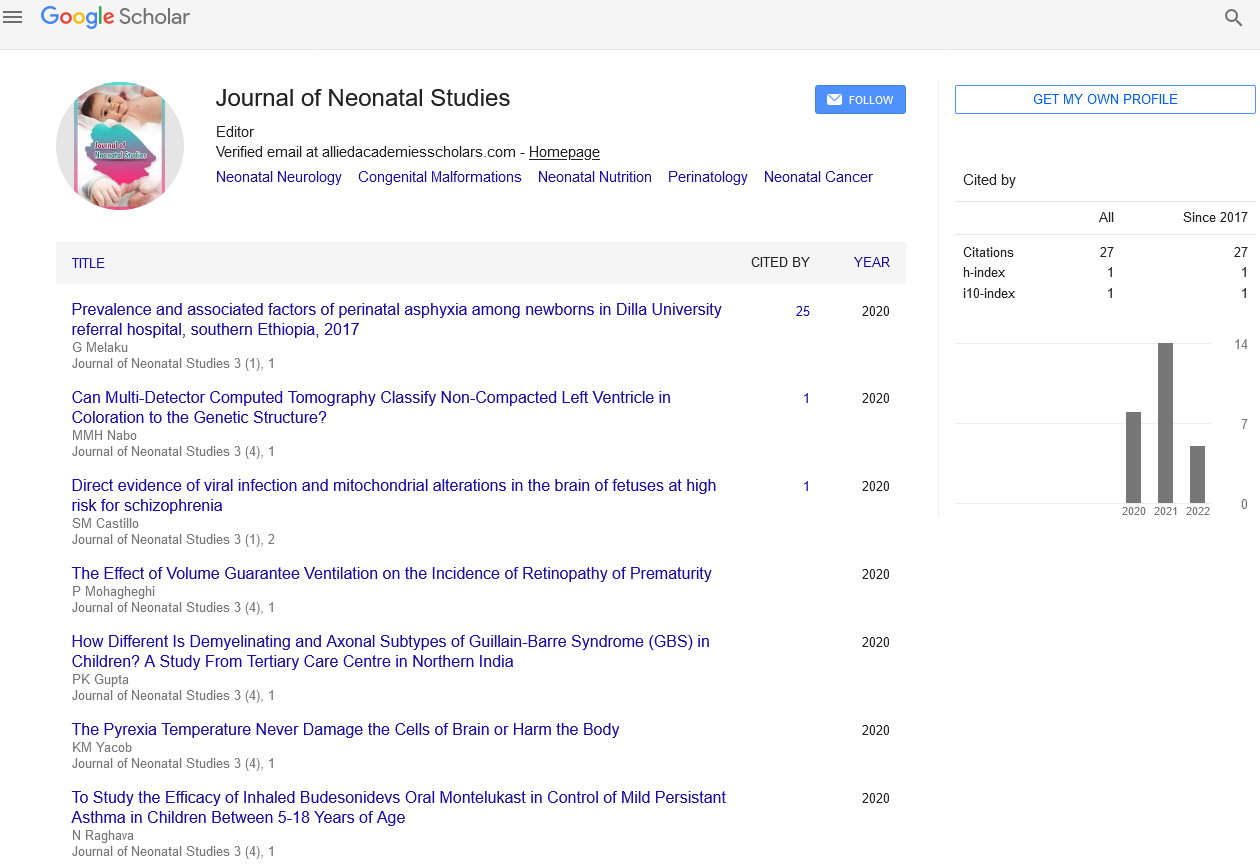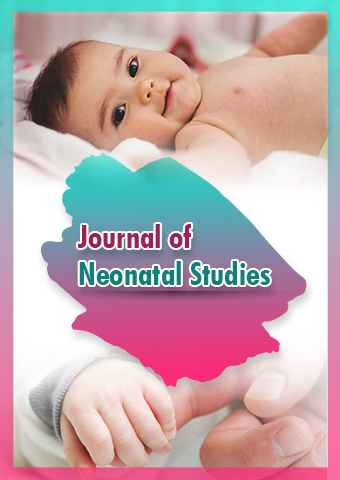Opinion Article - Journal of Neonatal Studies (2024) Volume 7, Issue 5
Cerebral Palsy in Neonates: Understanding, Diagnosis, and Management
- Corresponding Author:
- Parvin Farideh
Department of Neonatology, Shahid Beheshti University of Medical Sciences, Iran
E-mail: PFarideh55@sbmu.edu
Received: 02-Sep-2024, Manuscript No. JNS-24-150530; Editor assigned: 04-Sep-2024, PreQC No. JNS-24-150530 (PQ); Reviewed: 18-Sep-2024, QC No. JNS-24-150530; Revised: 23-Oct-2024, Manuscript No. JNS-24-150530 (R); Published: 30-Oct-2024, DOI: 10.37532/JNS.2024.7(5).267-269
Introduction
Cerebral Palsy (CP) is a group of permanent movement and posture disorders caused by non-progressive disturbances in the developing fetal or neonatal brain. CP is the most common motor disability in childhood, and its impact on the individual and their family can be profound. Understanding CP, especially its neonatal onset, is crucial for early diagnosis, management, and support for affected children and their families.
Description
What is cerebral palsy?
Cerebral palsy is not a single condition but rather a spectrum of disorders resulting from brain injuries or abnormalities. It affects muscle tone, movement, and motor skills, which can impair the ability to perform daily activities. The condition is caused by damage to the motor control centers of the developing brain, which can occur during pregnancy, childbirth, or shortly after birth.
Causes of neonatal cerebral palsy
Prenatal factors: The majority of CP cases are attributed to factors occurring before birth. These include:
• Intrauterine infections (e.g. rubella, cytomegalovirus, toxoplasmosis).
• Maternal health issues (e.g. thyroid problems, high blood pressure, infections).
• Genetic mutations affecting brain development.
• Poor fetal growth and placental insufficiency.
Perinatal factors: Complications during labor and delivery can contribute to CP, including:
• Birth asphyxia (lack of oxygen during birth).
• Premature birth (before 37 weeks of gestation).
• Low birth weight.
• Multiple births (e.g. twins, triplets).
• Rh incompatibility leading to severe jaundice and kernicterus.
Postnatal factors: Although less common, events occurring after birth can also cause CP:
• Neonatal infections (e.g. meningitis, encephalitis).
• Traumatic brain injuries.
• Severe jaundice leading to brain damage.
• Stroke.
Types of cerebral palsy
Cerebral palsy is categorized based on the type and distribution of motor impairment:
Spastic CP: Characterized by increased muscle tone, leading to stiff and jerky movements. Spastic CP is the most common type, affecting around 70-80% of individuals with CP.
Dyskinetic CP: Involves uncontrolled, involuntary movements. This type includes dystonia (twisting and repetitive movements) and choreoathetosis (slow, writhing movements).
Ataxic CP: Affects balance and coordination, leading to shaky movements and difficulties with precise actions such as writing or buttoning a shirt.
Mixed CP: When an individual exhibits symptom of more than one type of CP, it is referred to as mixed CP.
Diagnosis of cerebral palsy in neonates
Early diagnosis of CP is essential for initiating interventions that can improve outcomes. However, diagnosing CP in neonates can be challenging due to the developing nature of the brain and the subtlety of early symptoms. The diagnosis typically involves:
Clinical assessment: Observing the infant’s motor development, muscle tone, posture, and reflexes. Delayed milestones, abnormal muscle tone (either too stiff or too floppy), and unusual postures may raise suspicion of CP.
Neuroimaging: Brain imaging techniques such as Magnetic Resonance Imaging (MRI) and cranial ultrasound can help identify brain abnormalities associated with CP.
Developmental screening: Regular developmental screenings and assessments during well-baby visits can detect early signs of motor delays and other indicators of CP.
Genetic testing: In some cases, genetic testing may be recommended to identify underlying genetic factors contributing to CP.
Management and treatment of cerebral palsy
While there is no cure for CP, early intervention and comprehensive management can significantly improve the quality of life for affected individuals. Treatment plans are tailored to each child’s specific needs and may include:
Physical therapy: Physical therapy helps improve motor skills, strength, and flexibility. It involves exercises and activities designed to promote movement and prevent contractures (permanent muscle shortening).
Occupational therapy: Occupational therapy focuses on developing fine motor skills and improving the ability to perform daily activities such as eating, dressing, and writing.
Speech therapy: Speech therapy addresses communication difficulties, helping children develop speech and language skills, as well as alternative communication methods if needed.
Medications: Medications may be prescribed to manage symptoms such as muscle spasticity, seizures, and pain. Common medications include muscle relaxants, anticonvulsants, and anticholinergic drugs.
Assistive devices: Various assistive devices and technologies can help individuals with CP improve mobility and independence. These may include braces, walkers, wheelchairs, and communication devices.
Surgical interventions: In some cases, surgery may be recommended to address orthopedic issues such as contractures, hip dislocation, or scoliosis. Selective Dorsal Rhizotomy (SDR) is a surgical procedure that can reduce spasticity by cutting specific nerve fibers.
Early intervention programs: Early intervention services provide multidisciplinary support to infants and toddlers with developmental delays. These programs offer therapies, educational services, and family support to promote optimal development.
Support for families
Caring for a child with CP can be challenging, and families often need support to navigate the complexities of the condition. Support services for families may include:
Counseling and mental health support: Counseling services can help families cope with the emotional and psychological challenges of caring for a child with CP. Support groups and mental health professionals provide a safe space for sharing experiences and seeking advice.
Educational support: Special education services and Individualized Education Plans (IEPs) are designed to meet the unique learning needs of children with CP. Schools and educational institutions work closely with families to ensure that children receive appropriate accommodations and support.
Respite care: Respite care offers temporary relief for primary caregivers, allowing them to take a break while ensuring that their child receives quality care.
Financial assistance: Various programs and resources are available to help families manage the financial burden of medical care, therapies, and assistive devices.
Research and advances in cerebral palsy
Ongoing research continues to explore new treatments and interventions for CP, aiming to improve outcomes and quality of life for affected individuals. Some areas of focus include:
Stem cell therapy: Research is investigating the potential of stem cell therapy to repair damaged brain tissue and improve motor function in individuals with CP.
Robotics and wearable technology: Advances in robotics and wearable devices are providing new opportunities for improving mobility and motor skills through innovative rehabilitation techniques.
Genetic research: Genetic studies are identifying specific genes and mutations associated with CP, which may lead to targeted treatments and early interventions.
Neuroplasticity: Understanding the brain’s ability to reorganize and form new connections (neuroplasticity) is guiding the development of therapies that harness this potential for improving motor and cognitive function.
Conclusion
Cerebral palsy is a complex condition that requires a multifaceted approach to diagnosis, management, and support. Early intervention and comprehensive care can significantly improve outcomes for children with CP, helping them achieve their full potential. By understanding the causes, symptoms, and treatment options for neonatal CP, healthcare providers, families, and researchers can work together to enhance the quality of life for affected individuals.

